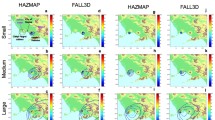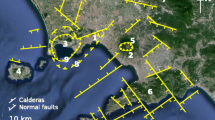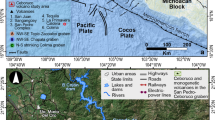Abstract
We present a comprehensive probabilistic hazard assessment for tephra fallout of Cotopaxi volcano (Ecuador), a quiescent but active stratovolcano known for its highly explosive behaviour. First, we developed a set of possible eruptive scenarios based on thorough field investigations, literature studies and using the Global Volcanism Program (GVP) database. Five eruption scenarios were identified, including two based on large pre-historical sub-Plinian/Plinian eruptions with eruptive parameters constrained from field investigations (One Eruption Scenario; OES) and three Eruption Range Scenarios (ERS) based on the Volcanic Explosivity Index (VEI) classification, for which eruptive parameters (i.e. erupted volume, plume height and median grainsize) were stochastically sampled within boundaries defined by VEI 3, 4 and 5. Second, the modelling was performed using the advection-diffusion model TEPHRA2 in combination with wind profiles from the NOAA NCEP/NCAR Reanalysis 1 database. We performed 1,000 runs for each eruption scenario, stochastically sampling a wind profile (OES and ERS) and a set of eruptive parameters (ERS only) at each run. Using the conditional probabilities of occurrence of eruption of VEI 3, 4 and 5 calculated from the GVP catalogue, we assessed the probability of tephra accumulation in a given time window. Based on the GVP database, a simple Poisson model shows that an eruption of VEI ≥3 has a 36 % probability of occurrence in the next 10 years. Finally, the hazard assessment was compiled based on three different outputs, including (i) probability maps for a given tephra accumulation, (ii) isomass maps for a given probability value and (iii) hazard curves for a given location. We conclude that the area west of Cotopaxi is exposed to light to severe tephra fallout for the smallest eruption magnitude considered (i.e. VEI 3). This area comprises a main communication axis (Panamerican Highway) topographically constrained at the bottom of the Interandean Valley, as well as the capital Quito and the town of Latacunga. In a companion paper, Biass et al. (this volume) propose a method for a rapid risk assessment for tephra fallout using global and easily accessible data and the hazard assessment described here.








Similar content being viewed by others
References
Aguilera E, Pareschi MT, Rosi M, Zanchetta G (2004) Risk from lahars in the northern valleys of Cotopaxi Volcano (Ecuador). Nat Hazards 33(2):161–189
Barberi F, Caruso P, Macedonio G, Pareschi M, Rosi M (1992) Reconstruction and numerical simulation of the lahar of the 1877 eruption of Cotopaxi volcano (Ecuador). Acta Vulcanol 2:35–44
Barberi F, Coltelli M, Frullani A, Rosi M, Almeida E (1995) Chronology and dispersal characteristics of recently (last 5000 years) erupted tephra of Cotopaxi (Ecuador): implications for long-term eruptive forecasting. J Volcanol Geotherm Res 69(3–4):217–239
Biass S, Bonadonna C (2011) A quantitative uncertainty assessment of eruptive parameters derived from tephra deposits: the example of two large eruptions of Cotopaxi volcano, Ecuador. Bull Volcanol 73(1):73–90
Blong R (2003) Building damage in Rabaul, Papua New Guinea, 1994. Bull Volcanol 65(1):43–54
Blong RJ (1984) Volcanic hazards. A sourcebook on the effects of eruptions. Academic Press, Orlando
Bonadonna C (2006) Probabilistic modelling of tephra dispersion. In: Mader HM, Coles SG, Connor CB, Connor LJ (eds) Statistics in volcanology, Special Publications of IAVCEI, vol 1. Geological Society of London, London, pp 243–259
Bonadonna C, Macedonio G, Sparks RSJ (2002) Numerical modelling of tephra fallout associated with dome collapses and Vulcanian explosions: application to hazard assessment on Montserrat. In: Druit T, Kokelaar B (eds) The eruption of Soufriere Hills Volcano, Montserrat, from 1995 to 1999, The Geological Society, London, Memoirs, vol 21. The Geological Society of London, London, pp 517–537
Bonadonna C, Connor CB, Houghton BF, Connor L, Byrne M, Laing A, Hincks TK (2005) Probabilistic modeling of tephra dispersal: hazard assessment of a multiphase rhyolitic eruption at Tarawera, New Zealand. J Geophys Res 110(10.1029):B03203
Borradaile GJ (2003) Statistics of earth science data: their distribution in time, space, and orientation. Springer, Berlin
Chester DK, Degg M, Duncan AM, Guest JE (2000) The increasing exposure of cities to the effects of volcanic eruptions: a global survey. Environ Hazard 2(3):89–103
Connor CB, Hill BE, Winfrey B, Franklin NM, La Femina PC (2001) Estimation of volcanic hazards from tephra fallout. Nat Hazard Rev 2(1):33–42
De la Cruz-Reyna S (1993) Random patterns of occurrence of explosive eruptions at Colima Volcano, Mexico. J Volcanol Geotherm Res 55(1–2):51–68
D’Ercole R (1996) Représentations cartographiques des facteurs de vulnérabilité des populations exposées à une menace volcanique. Application à la région du volcan Cotopaxi (Equateur). Bull Inst fr études andines 25(3):479–507
D’Ercole R, Demoraes F (2003) Risques et réponses institutionnelles en Equateur–Cartes et méthodes. Cahiers de Géographie Collect EDYTEM 1:157–168
Dzierma Y, Wehrmann H (2010) Eruption time series statistically examined: probabilities of future eruptions at Villarrica and Llaima Volcanoes, Southern Volcanic Zone, Chile. J Volcanol Geotherm Res 193(1–2):82–92
EM-DAT (2011) EM-DAT: The OFDA/CRED International Disaster Database. http://www.emdat.be. Accessed 12 Feb 2011
Fournier d’Albe EM (1979) Objectives of volcanic monitoring and prediction. J Geol Soc Lond 136:321–326
Guffanti M, Mayberry GC, Casadevall TJ, Wunderman R (2009) Volcanic hazards to airports. Nat Hazards 51(2):287–302
Hall M, Hillebrandt vC (1988) Mapa de los peligros volcanicos potenciales asociados con el volcan cotopaxi: (1) zona norte and (2) zona sur. Instituto Geofisico, Quito
Hall M, Mothes P (2008) The rhyolitic–andesitic eruptive history of Cotopaxi volcano, Ecuador. Bull Volcanol 70(6):675–702
Haynes K, Barclay J, Pidgeon N (2007) Volcanic hazard communication using maps: an evaluation of their effectiveness. Bull Volcanol 70(2):123–138. doi:10.1007/s00445-007-0124-7
Hellström T (2007) Critical infrastructure and systemic vulnerability: towards a planning framework. Saf Sci 45(3):415–430
Hill BE, Connor CB, Jarzemba MS, La Femina PC, Navarro M, Strauch W (1998) 1995 eruptions of Cerro Negro volcano, Nicaragua, and risk assessment for future eruptions. Geol Soc Am Bull 110(10):1231
Horwell CJ, Baxter PJ (2006) The respiratory health hazards of volcanic ash: a review for volcanic risk mitigation. Bull Volcanol 69(1):1–24
Horwell CJ, Sparks RSJ, Brewer TS, Llewellin EW, Williamson BJ (2003) Characterization of respirable volcanic ash from the Soufrière Hills volcano, Montserrat, with implications for human health hazards. Bull Volcanol 65(5):346–362
Hurst T, Smith W (2004) A Monte Carlo methodology for modelling ashfall hazards. J Volcanol Geotherm Res 138(3–4):393–403
Inbar M, Ostera HA, Parica CA, Remesal MB, Salani FM (1995) Environmental assessment of 1991 Hudson volcano eruption ashfall effects on southern Patagonia region, Argentina. Environ Geol 25(2):119–125
Inman DL (1952) Measures for describing the size distribution of sediments. J Sediment Res 22(3):125–145
Jenkins S, Magill C, McAneney J, Blong R (2012a) Regional ash fall hazard I: a probabilistic assessment methodology. Bull Volcanol 1–14. doi:10.1007/s00445-012-0627-8
Jenkins S, McAneney J, Magill C, Blong R (2012b) Regional ash fall hazard II: Asia-pacic modelling results and implications. Bull Volcanol 1–15. doi:10.1007/s00445-012-0628-7
Johnston DM, Houghton BF, Neall VE, Ronan KR, Paton D (2000) Impacts of the 1945 and 1995–1996 Ruapehu eruptions, New Zealand: an example of increasing societal vulnerability. Geol Soc Am Bull 112(5):720–726
Jones G, Chester DK, Shooshtarian F (1999) Statistical analysis of the frequency of eruptions at Furnas Volcano, São Miguel, Azores. J Volcanol Geotherm Res 92(1–2):31–38
Kalnay EC, Kanamitsu M, Kistler R, Collins W, Deaven D, Gandin L, Iredell M, Saha S, White G, Woollen J (1996) The NCEP/NCAR 40-year reanalysis project. Bull Am Meteorol Soc 77(3):437–471
Marti J, Spence R, Calogero E, Ordo ez A, Felpeto A, Baxter P (2008) Estimating building exposure and impact to volcanic hazards in Icod de los Vinos, Tenerife (Canary Islands). J Volcanol Geotherm Res 178(3):553–561
Martin RS, Watt SFL, Pyle DM, Mather TA, Matthews NE, Georg RB, Day JA, Fairhead T, Witt MLI, Quayle BM (2009) Environmental effects of ashfall in Argentina from the 2008 Chaitén volcanic eruption. J Volcanol Geotherm Res 184(3–4):462–472
Marzocchi W, Woo G (2009) Principles of volcanic risk metrics: theory and the case study of Mount Vesuvius and Campi Flegrei, Italy. J Geophys Res 114(B3):B03,213
Mendoza-Rosas AT, la Cruz-Reyna S (2008) A statistical method linking geological and historical eruption time series for volcanic hazard estimations: applications to active polygenetic volcanoes. J Volcanol Geotherm Res 176(2):277–290
Millard GA, Mather TA, Pyle DM, Rose WI, Thornton B (2006) Halogen emissions from a small volcanic eruption: modeling the peak concentrations, dispersion, and volcanically induced ozone loss in the stratosphere. Geophys Res Lett 33:33–34
Moteff J, Copeland C, Fischer J (2003) Critical infrastructures: what makes an infrastructure critical? Report for Congress RL31556, Congressional Research Service, Library of Congress, Washington, DC, Accessed 13 Feb 2011
Mothes P, Hall ML, Andrade D, Samaniego P, Pierson TC, Ruiz AG, Yepes H (2004) Character, stratigraphy and magnitude of historical lahars of Cotopaxi Volcano (Ecuador). Acta Vulcanol 16(1/2):85
Neri A, Aspinall WP, Cioni R, Bertagnini A, Baxter PJ, Zuccaro G, Andronico D, Barsotti S, Cole PD, Esposti Ongaro T (2008) Developing an event tree for probabilistic hazard and risk assessment at Vesuvius. J Volcanol Geotherm Res 178(3):397–415
Newhall C (2000) Volcano warnings. In: Sigurdsson H, Houghton BF, Ballard RD (eds) Encyclopedia of volcanoes. Academic Press, London, pp 263–269
Newhall C, Hoblitt R (2002) Constructing event trees for volcanic crises. Bull Volcanol 64(1):3–20
Newhall CG, Self S (1982) The volcanic explosivity index/VEI/—an estimate of explosive magnitude for historical volcanism. J Geophys Res 87(C2):1231–1238
Pistolesi M, Rosi M, Cioni R, Cashman KV, Rossotti A, Aguilera E (2011) Physical volcanology of the post-twelfth-century activity at Cotopaxi volcano, Ecuador: behavior of an andesitic central volcano. Geol Soc Am Bull 123(5-6):1193–1215. doi:10.1130/B30301.1
Pomonis A, Spence R, Baxter P (1999) Risk assessment of residential buildings for an eruption of Furnas Volcano, Sao Miguel, the Azores. J Volcanol Geotherm Res 92(1–2):107–131
Pyle DM (2000) Sizes of volcanic eruptions. In: Sigurdsson H, Houghton BF, Ballard RD (eds) Encyclopedia of volcanoes. Academic Press, London, pp 263–269
Robock A (2000) Volcanic eruptions and climate. Rev Geophys 38(2):191–219
Siebert L, Simkin T (2002) Volcanoes of the world: an illustrated catalog of holocene volcanoes and their eruptions. Smithsonian Institution, Global Volcanism Program Digital Information Series, GVP-3 URL http://www.volcano.si.edu/world
Siebert L, Simkin T, Kimberly P (2010) Volcanoes of the World. University of California Press, London
Simkin T, Siebert L (1994) Volcanoes of the World. Geoscience Press, Tucson
Small C, Naumann T (2001) The global distribution of human population and recent volcanism. Environ Hazard 3(3–4):93–109. doi:10.1016/S1464-2867(02)00002-5. URL: http://www.sciencedirect.com/science/article/pii/S1464286702000025
Spence RJS, Pomonis A, Baxter PJ, AW C (1996) Building damage caused by the Mount Pinatubo eruption of June 15, 1991. University of Washington Press, Seattle, pp 1053–1061
Spence RJS, Kelman I, Baxter PJ, Zuccaro G, Petrazzuoli S (2005) Residential building and occupant vulnerability to tephra fall. Nat Haz Earth Syst Sci 5(4):477–494
Swindles GT, Lawson IT, Savov IP, Connor CB, Plunkett G (2011) A 7000 yr perspective on volcanic ash clouds affecting northern Europe. Geology 39(9):887–890. doi:10.1130/G32146.110.1130/G32146.1. URL: http://geology.gsapubs.org/cgi/content/abstract/39/9/887, http://geology.gsapubs.org/cgi/reprint/39/9/887.pdf
Wilson T, Cole J, Cronin S, Stewart C, Johnston D (2011a) Impacts on agriculture following the 1991 eruption of Vulcan Hudson, Patagonia: lessons for recovery. Nat Hazards 57:185–212. doi:10.1007/s11069-010-9604-8
Wilson T, Cole J, Stewart C, Cronin S, Johnston D (2011b) Ash storms: impacts of wind-remobilised volcanic ash on rural communities and agriculture following the 1991 Hudson eruption, southern Patagonia, Chile. Bull Volcanol 73:223–239. doi:10.1007/s00445-010-0396-1
Wilson TM, Stewart C, Sword-Daniels V, Leonard GS, Johnston DM, Cole JW, Wardman J, Wilson G, Barnard ST (2012) Volcanic ash impacts on critical infrastructure. Phys Chem Earth Pt A/B/C 45–46:5–23. doi:10.1016/j.pce.2011.06.006
Zuccaro G, Cacace F, Spence RJS, Baxter PJ (2008) Impact of explosive eruption scenarios at Vesuvius. J Volcanol Geotherm Res 178(3):416–453
Acknowledgments
This research was possible thanks to the generous support of the Fondation Marc Birkigt, Geneva (S. Biass). We are grateful to William Aeberhard and Corine Frishcknecht for the invaluable scientific discussions and to two anonymous reviewers whose comments greatly improved this manuscript.
Author information
Authors and Affiliations
Corresponding author
Electronic supplementary material
Below is the link to the electronic supplementary material.
Rights and permissions
About this article
Cite this article
Biass, S., Bonadonna, C. A fast GIS-based risk assessment for tephra fallout: the example of Cotopaxi volcano, Ecuador. Nat Hazards 65, 477–495 (2013). https://doi.org/10.1007/s11069-012-0378-z
Received:
Accepted:
Published:
Issue Date:
DOI: https://doi.org/10.1007/s11069-012-0378-z




